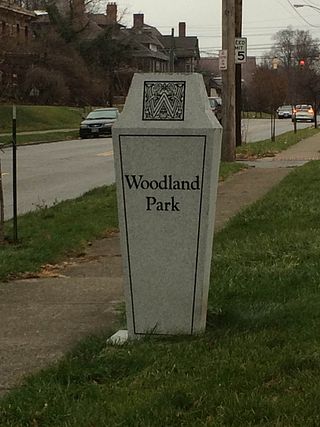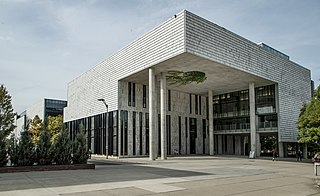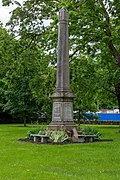
Columbus is the state capital and the most populous city in the U.S. state of Ohio. With a 2020 census population of 905,748, it is the 14th-most populous city in the U.S., the second-most populous city in the Midwest, after Chicago, and the third-most populous state capital. Columbus is the county seat of Franklin County; it also extends into Delaware and Fairfield counties. It is the core city of the Columbus metropolitan area, which encompasses 10 counties in central Ohio. It had a population of 2,138,926 in 2020, making it the largest metropolitan entirely in Ohio and 32nd-largest city in the U.S.

The Ohio Statehouse is the state capitol building and seat of government for the U.S. state of Ohio. The Greek Revival building is located on Capitol Square in Downtown Columbus. The capitol houses the Ohio General Assembly, consisting of the House of Representatives and the Senate. It also contains the ceremonial offices of the governor, lieutenant governor, state treasurer, and state auditor. Built between 1839 and 1861, it is one of the oldest working statehouses in the United States. The statehouse grounds include two other buildings, the Judiciary Annex or Senate Building, and the Atrium; the three are collectively referred to as the Ohio Statehouse into the present day.

Green Lawn Cemetery is a historic private rural cemetery located in Columbus, Ohio, in the United States. Organized in 1848 and opened in 1849, the cemetery was the city's premier burying ground in the 1800s and beyond. An American Civil War memorial was erected there in 1891, and chapel constructed in 1902. With 360 acres (150 ha), it is Ohio's second-largest cemetery.

Franklinton is a neighborhood in Columbus, Ohio, just west of its downtown. Settled in 1797, Franklinton is the first American settlement in Franklin County, and was the county seat until 1824. As the city of Columbus grew, the city annexed and incorporated the existing settlement in 1859. Franklinton is bordered by the Scioto River on the north and east, Harmon Avenue on the east, Stimmel Road and Greenlawn Avenue on the south, and Interstate 70 on the west. Its main thoroughfare is West Broad Street, one of the city's two main roads.
West Columbus, sometimes referred to as westside or the West Side, is a neighborhood in Columbus, Ohio, United States. Unlike other Columbus neighborhoods, it is a broad geographical term used by locals rather than a subdivision or suburb. West Columbus is defined as the entire southwest side of Columbus, bordered on the north by interstates 70 and 670, within Interstate 71 on the east, and on the south and west by the city limits that reach several miles to the outside of the I-270 outerbelt. It covers the ZIP Codes 43223, 43204, 43228, and 43222.
Columbus, the state capital and Ohio's largest city, has numerous neighborhoods within its city limits. Neighborhood names and boundaries are not officially defined. They may vary or change from time to time due to demographic and economic variables.
Lincoln Goodale was the first doctor to live in Columbus, Ohio, United States. He was a great benefactor to the city and his legacy includes a large parcel of land that today is known as Goodale Park. His likeness in the form of a large bronze bust watches over the park.

Goodale Park is a public park in the Victorian Village area of Columbus, Ohio. It was donated to the city in 1851 by Lincoln Goodale. For a few months during the Civil War, it was a staging area for Union troops known as Camp Jackson. ComFest, a large, free, multi-day, non-corporate, music and arts annual festival, is held in the park in June.

Mount Calvary Cemetery is a Roman Catholic cemetery in Columbus, Ohio, located west of downtown next to Green Lawn Cemetery and by the now-abandoned Cooper Stadium. It is the oldest active Catholic cemetery in Franklin County. It is maintained by the Roman Catholic Diocese of Columbus, and has approximately 40,000 interments over 40 acres (16 ha).

Woodland Park is a residential neighborhood located in the Near East Side of Columbus, Ohio that houses approximately 1,500 residents. The neighborhood was previously home to such figures as artist Emerson Burkhart, cartoonist Billy Ireland, and judge William Brooks. Established in the early 20th century, Woodland Park has grown from its planned neighborhood roots into a modest neighborhood that contains various faith communities, schools, sources of entertainment and recreation, and borders an extension of the Ohio State University medical center.

George John Karb was the 30th and 39th mayor of Columbus, Ohio and the 27th person to serve in that office. He was first elected in 1890 and served Columbus for two consecutive terms. After four years as mayor, he was elected as Sheriff of Franklin County. He later resought election in the 1911 mayoral campaign and defeated incumbent Republican mayor George S. Marshall. He served Columbus as mayor during World War I and the Spanish Influenza of 1918. After three consecutive terms in office Karb was defeated in the 1919 mayoral election by James J. Thomas. Karb died on May 15, 1937.

William T. Martin was the fifth mayor of Columbus, Ohio. He was appointed by the Burough Council of Columbus in 1824 and served Columbus for three consecutive terms. His successor was Philo H. Olmsted. He died on February 19, 1866 and is interred in Green Lawn Cemetery.

Lucas Sullivant, was the founder of Franklinton, Ohio, the first American settlement near the Scioto River in central Ohio.
The following is a timeline of the history of the city of Columbus, Ohio, United States.
Columbus, the capital city of Ohio, was founded on the east bank of the Scioto River in 1812. The city was founded as its capitol, beside the town of Franklinton, since incorporated into Columbus. The city's early history was gradual, as residents dealt with flooding and cholera epidemics, and the city had few direct connections to other cities. This led creation of a feeder canal, and later, freight and passenger railroads. The city became known for its industry and commercial businesses into the 20th century, though it experienced a lull in development in the late 20th century. In the 21st century, Columbus has been increasingly revitalized, led by parks projects, new developments, and efforts to beautify individual neighborhoods.

Celebration of Life, also known as the Arthur Boke/Sarah Sullivan statue, is a 2004 bronze sculpture by Alfred Tibor, installed near Franklinton's Genoa Park, in Columbus, Ohio, United States. The artwork depicts a woman holding a baby above her head, and commemorates Arthur Boke, the first known black child born in Franklinton, and Sarah Sullivant, the wife of Lucas Sullivant. The Sullivants, a white couple, raised Boke as their own child.

The architecture of Columbus, Ohio is represented by numerous notable architects' works, individually notable buildings, and a wide range of styles. Yost & Packard, the most prolific architects for much of the city's history, gave the city much of its eclectic and playful designs at a time when architecture tended to be busy and vibrant.

The Great Flood of 1913 severely affected Columbus, Ohio. The area most affected was Franklinton, also known as the Bottoms, for its low elevation near the Scioto River. Among many infrastructure projects, a 7.2-mile floodwall was built from 1993 to 2004 to protect most of Franklinton from flooding.

The 1910 streetcar strike was a union protest against labor practices by the Columbus Railway and Light Co. in Columbus, Ohio in 1910. The summertime strike began as peaceful protests, but led to thousands rioting throughout the city, injuring hundreds of people.


















